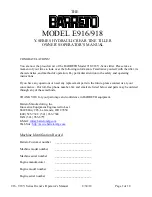
YZ Engineering Guide
Form: 161.01-EG1 (0618)
18
Ventilation
- Some standards requires that all machinery rooms be vented to the outdoors utilizing mechanical ventilation
by one or more fans. State, local and any other related codes should be reviewed for specific requirements. Since the
YZ chiller motor is hermetically sealed, no additional ventilation is needed due to motor heat.
In addition, the ASHRAE Standard 15 requires a refrigerant vapor detector to be employed for all refrigerants. It is to be
located in an area where refrigerant from a leak would be likely to concentrate. An alarm is to be activated and the
mechanical ventilation started at a value no greater than the Threshold Limit Value (TLV) of the refrigerant.
WATER CIRCUITS
Flow Rate
- For normal water chilling duty, evaporator and condenser flow rates are permitted at water velocity levels in
the heat exchanger tubes of between 0.91m/s and 3.66m/s (3.0 fps and 12.0 fps) for evaporators and 1.0m/s and 3.66m/s
(3.3 fps and 12.0 fps) for condensers. Two pass units are also limited to 134kPa (45ft H
2
O) water pressure drop. The
three pass limit is 201kPa (67.5ft H
2
O). Variable flow in the condenser is not recommended, as it generally raises the
energy consumption of the system by keeping the condenser pressure high in the chiller. Additionally, the rate of fouling
in the condenser will increase at lower water velocities associated with variable flow, raising system maintenance costs.
Cooling towers typically have narrow ranges of operation with respect to flow rates, and will be more effective with full
design flow.
The chillers can tolerate a 50% flow rate change in one minute that is typically associated with the staging on or off of an
additional chiller; however a lower flow rate change is normally used for better system stability and set point control.
Proper sequencing via the building automation system will make this a very smooth transition.
Variable Primary Flow
- There is increasing interest to use variable primary flow (VPF) systems in large chilled water
plants. VPF systems can offer lower installation and operating costs in many cases, but do require more sophisticated
control and flow monitoring. YZ chillers will operate successfully in VPF systems. With a minimum allowable evaporator
tube velocity of 0.5m/s (1.5 fps) for standard tubes at part load rating conditions, YZ chillers will accommodate the wide
variation in flow required by many chilled water VPF applications.
Temperature Ranges
-
For normal water chilling duty, leaving chilled water temperatures may be selected between
3.5°C (38°F) and 21.0°C (70°F) to obtain temperature deltas between entering chilled and leaving chilled water
temperature of 1.7°C up to 16.7°C (3°F up to 30°F).
Water Quality
-
The practical and economical application of liquid chillers requires that the quality of the water supply
for the condenser and evaporator be analyzed by a water treatment specialist. Water quality may affect the performance
of any chiller through corrosion, deposition of heat-resistant scale, sedimentation or organic growth. These will degrade
chiller performance and increase operating and maintenance costs. Normally, performance may be maintained by
corrective water treatment and periodic cleaning of tubes. If water conditions exist which cannot be corrected by proper
water treatment, it may be necessary to provide a larger allowance for fouling, and/or to specify special materials of
construction.
General Piping
- All chilled water and condenser water piping should be designed and installed in accordance with
accepted piping practice. Chilled water and condenser water pumps should be located to discharge through the chiller
to assure positive pressure and flow through the unit. Piping should include offsets to provide flexibility and should be
arranged to prevent drainage of water from the evaporator and condenser when the pumps are shut off. Piping should
be adequately supported and braced independently of the chiller to avoid the imposition of strain on chiller components.
Hangers must allow for alignment of the pipe. Isolators in the piping and in the hangers are highly desirable in achieving
sound and vibration control.
Convenience Considerations
- To facilitate the performance of routine maintenance work, some or all of the following
steps may be taken by the purchaser. Evaporator and condenser waterboxes are equipped with plugged vent and drain







































